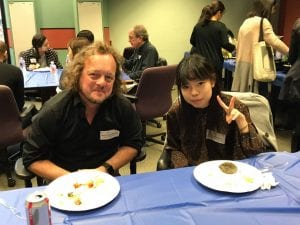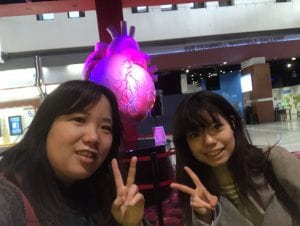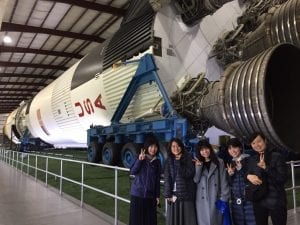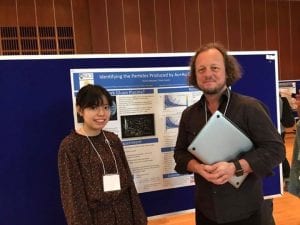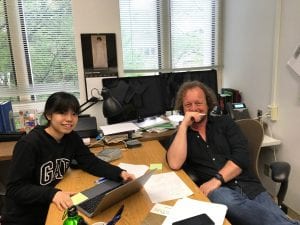[:en]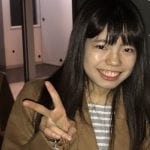 Yurina Nakazato
Yurina Nakazato
Hometown in Japan: Okinawa
University in Japan: The University of Tokyo
Major & School Year: Physics, B2: Sophomore
Host Advisor: Prof. Frank Geurts, Dept. of Physics & Astronomy
Host Lab: Ultrarelavistic Heavy-Ion Physics Lab
Research Project (PDF): “Identifying the Particles Produced by Au+Au Collisions”
Why TOMODACHI STEM @ Rice University?
Astrophysics has been my passion since I was a high school student. My future research interests focus on how the universe was created. There are two main reasons why I believe the TOMODACHI STEM program would help me achieve this goal. First, this program enables me to study physics with talented international students. I am keen to begin learning physics in a competitive environment with students. Moreover, I will be able to interact with students who have different academic backgrounds from various Japanese universities. I would like to interact with students who are highly motivated as it will help me become a more internationally competitive researcher. Given that the number of female physics researchers remains low, I believe that participating in this program will give me an opportunity to share my passion for a future career in physics with like-minded female students.
Second, for my future research in astrophysics, I will be able to be more involved in international astrophysics research. After the TOMODACHI STEM program, I would like to share an academic network by keeping in touch with the students and researchers at Rice University. Also, I would like to actively join workshops and academic conferences in the future. By attending this program, I aim to get more opportunities to participate in the international academic community.
For these reasons, participating in the TOMODACHI STEM program will be a significant first step for my future research career.
Goals
- Improve my English skills for more productive communication with international researchers
- Interact with talented international students at Rice University and the other participants of this program
- Make an effort to absorb a lot of knowledge in astrophysics
- Do well on my final research project poster presentation at Rice University
- Enjoy every moment during this program
Excerpts from Yurina’s Weekly Reports
- Week 01: Arrival in the U.S.
- Week 02: First Week at Research Host Lab
- Week 03: Interview With a Female Researcher
- Week 04: Research in the U.S. vs. Research in Japan
- Final Research Poster Presentation
- Week 05: Science & Technology Policy Study Tour
- Final Report
- Tips for Future Participants
Week 01: Arrival in the U.S.
What I was most surprised at when I first arrived was that people in Houston were so friendly. In the morning buffet at the hotel, the staff talked to me “Good morning, how are you?” Then, I replied and talked with her for a while. Also, when I get on the shuttle bus or on the elevator at the hotel, people talked to me “Hey, where are you from?”, “Have a good day in Houston!” If I was spoken to in such way in Japan, I would be confused and wonder “why are they speaking to me without any particular reasons?!”. Through this experience, I found activeness of American people and the shyness of Japanese people. I decided to become more confident by reflecting on myself through this program.
This week, I had seminars at Rice University almost every day. In particular, Prof. Kono’s seminar was the most helpful for me. He explained about graduate study in the U.S.. I didn’t know about the system, the cost, and the requirements for the graduate study in the U.S. I also asked him about studying in the U.S. in more detail and the experiences of other Japanese graduate students who go to U.S. universities. I’m debating which graduate school I should go to, in Japan or in the U.S., but his seminar gave me a more concrete plan to study in the U.S. (For more, see the section on Professional Development: Graduate School Resources in the U.S.)
On my first weekend in Houston, we went to the Houston Museum Of Natural Science (HMNS). I stayed there from 10 a.m. to 4 p.m., so I saw all of the sections. The most impressive section for me was the dinosaur exhibit because Kyoko explained to in detail about the fossils. Her explanation enabled us to understand dinosaurs much better. We also asked the curators a lot of questions. They answered our questions so kindly and were excited to share this new knowledge with us. Finally, we could enter the dinosaur laboratory! There were a lot of devices to clean fossils and some original fossils which were not exhibited to the public. It was great opportunity.
I spent an immensely rich week so that I feel as though I have already lived in Houston for 2 or 3 weeks. I’m so looking forward to spending such a rich week in the second week!
Initial Reflections on Intercultural Experiences in the U.S.
During my first week in the U.S., I encountered one of the U.S. core values a lot, “Self-reliance.” It was impressive to me that asking a lot of questions to my professor was preferable. In Japan, I don’t ask my teachers very many questions even though I don’t understand their lecture. I was always worried if I would seem to be less intelligent or that I might bother the other students in the lecture by asking questions. However, in Rice, when I ask my professor something during his talk, he said ‘Good question!’ and answered my question in detail. From these experiences, I found that Japanese have less self-reliance and it was very important to ask questions spontaneously. Asking everything when one wants to may sometimes seem to be a self-centered act, but I think it enables us to share own questions and understand them much more.
During my first week in the U.S., I also encountered “wa” as one of my Japanese Core Values. When I was asked something and raised my hand, I first watched to see whether other people raised their hand or not or if they raised their hand in a different manner. In Japan, I tend to show the same opinion as the majority shows even though I may have the opposite one. I think “wa” leads less “Self-Reliance” and it is important to find a balance between them.
Question of the Week
I was so surprised that people move almost by car or bus, not foot. In my home university there are no shuttle buses even though the campus size is the almost same as one of Rice University. It is natural to walk everywhere in campus for 15~20minutes. Is using cars or buses as everyday transportation common in Houston? Or in the whole of the U.S.?
- Yes, in general the U.S. is a much more car orientated society and we drive even short distances in most places where in Europe or Japan people would walk. This may be partially because the roads are generally bigger and easier to drive and, in a city like Houston, there is almost always free parking. However, it is different in cities like San Francisco, New York, or Boston where parking is very expensive – especially in the city center.
- A lot of universities do offer free shuttle bus services on campus in the U.S., but yes Rice is pretty small so it is a bit surprising that we have such excellent campus transportation. It depends on each school though; not all universities in the U.S. have a free campus shuttle like this. Also, on most university campuses students, faculty, and staff have to pay to park in one of the parking lots. This can be very expensive and parking space is limited, so universities offer free campuses often offer free metro/bus passes or free campus transportation to encourage people to not rely so much on cars. For example, at Rice degree-seeking graduate students can buy a Houston Metro Q Card for just $55 that is good for the entire academic year which would normally cost $500.
Preparing for Research in the U.S. and First Few Days in the Lab
While I was still in Japan, I communicated in advance with my host professor, Professor Geurts. He told me to install ROOT, do its tutorials, and read some papers he sent me. Actually, I was worried about my research at Rice because I was not confident if I could analyze data with my programming skills and I could not understand a lot of the paper.
I met my host professor first at the welcome party lunch on Tuesday Feb 19th. I was so glad to meet him and was so surprised to learn that my mentor would be Prof. Geurts himself. He had already prepared a room and a desktop for me! We discussed the characteristics of quarks and the devices which detect particles. It was such a great time to discuss with him one-on-one. Moreover, he demonstrated a cloud chamber experiment to me. I’ve seen this experiment only in my textbook, so I was so impressed that I could see the tracks of the cosmic ray with my own eyes.
My research topic is to analyze the data of the STAR experiment. In order to understand what the data shows, I have to know the mechanism of the devices and the characteristics of particles generated by the heavy ion collision. This week, I read several papers about the detectors and practiced programming.
Return to Top
Week 02: First Week at Research Host Lab
Each day, I usually work in my lab from 9 a.m. to 5p.m. When I first arrive at the lab, I ask my host professor what time he would like to meet with me that day since my professor is also my mentor for this project. Each day, I have a one and half an hour meeting with him. The theme of each meeting is different, so we talk about many things such as the mechanism of the detector, electromagnetics, and programming. It is such a great opportunity to be able to ask questions to my host professor directly every day!
I think my listening and reading English skills have already improved because, over the last two weeks, I have attended some seminars and read a lot of papers in English. At first, it was so hard for me to read papers, not because they were in English, but because there were a lot of technical words. I think these papers would be so difficult to read even if they were written in Japanese. However, my conversational English still needs improvement; I tend to speak in broken English and don’t always say things in the correct way. Also, even though I don’t know how to say technical words of physics, I can express the symbols of physical equations, then Frank can understand what I want to say – thanks to the same physical symbols being used all over the world. J lol. From next week, I will practice speaking English more fluently.
I was surprised that it is common in the U.S. for some undergraduate students, such as sophomore and juniors, to have already conducted research. In my home university, I will not be able to join a lab until my senior year. I think the system of the U.S. university is great because even sophomore and junior students need to have an opportunity to research together with graduate students and professors. They can learn how to read papers, build one’s network, and get motivated to study their fields.
I had a very fulfilling time this weekend and did lots of things from Friday night until Sunday. On Friday night, I went to an orchestra concert at Stude Concert Hall in Rice’s Shepherd School of Music. I was so surprised that there was a concert hall at the university. The concert was great and I could feel how much the orchestra members had practiced for the concert. Since I had never gone to any orchestra concerts before, it was nice opportunity. On Saturday, I went to the Health Museum with Kyoko. To get there, we used the Metro for the first time. We didn’t know how to get tickets, so we asked several people. In the museum, there were a lot of exhibitions about the human body. We were surprised that we could touch a human brain and heart and a cow’s eye. We had never thought that we would have an opportunity to touch and observe human organs because we are not medical students. They were a little bit grotesque, but I was glad I had the opportunity to touch them.
On Sunday, I went to NASA finally! I’d wanted to visit there since I applied to this program. Actually I went there five years ago, but I participated in the mission control center tour, not the astronaut training facility tour. Therefore, the current tour was a great opportunity to visit the building where NASA astronauts train for current missions and see the next generation of space exploration vehicles. Also, I could understand what the guide said much better than I could five years ago because my English listening skill have improved and I have studied space devices at my university. I was so happy to enjoy NASA from a different perspective than before.
Research Project Update
My research project is to analyze the data of heavy ion collision (the STAR experiment). A brief explanation of the STAR experiment is that the two accelerated particles (such as a proton or Au nucleus) are collided and the collision reproduces quark gluon plasma(QGP). The experiment will help find the state just after the Big Bang and the characteristics of QGP. There are many kinds of data such as the flight of time, the noise of time, and the momentum of generated particles. For the poster presentation, I will analyze the data of mass and momentum and distinguish the type of the particles.
First, I had to understand what the data means. In order to understand it, I read some papers about the particle detections and discussed their mechanisms with Frank. Also, I had to understand why the physical quantities were necessary, so I derived an equation considering special relativity. To analyze the data, I use ROOT, a modular scientific software toolkit. It is mainly written in C++, so I had to practice C++ programming. Actually, I was not familiar with programming, so I searched and practiced it a lot. Frank taught me the way to use ROOT from the beginning, so I could run the code and make graphs on my own laptop. In addition, I needed to study particle physics and understand the characteristics of generated particles to distinguish them.
This week, I also discussed the contents of my poster with him. We decided to use the data which distinguishes the type of the particles because it is easy for other people who don’t know very much physics to understand our research. I have already made my poster draft except for results and discussion. Therefore, I will run the code and make my graphs next week. Also, I will study particle physics in order to be able to explain my research in detail when people ask me questions. Besides analyzing the data of mass and momentum, I analyze the data of noise because Frank analyzes it mainly for his work. This week, I collected the noise data. I was so glad to research not only for my poster presentation but also for my host professor’s daily research.
Question of the Week
I was surprised that I’ve never seen any washlet (electric toilet seat) since I came to Houston, even in the airport and the hotel! Why are washlet is not prevalent in America?
- Bidets, in general, aren’t very common in the U.S. and Washlets have just never become very popular. Largely because they are much more expensive than a standard toilet. Some people are starting to use bidet toilet seats but they are still considered a luxury/uncommon item. I doubt that Washlets will ever become very common in the U.S. due to their cost and the fact that they require new electrical connections be built into the buildings/bathrooms that are not standard in U.S. building/construction today.
- For more on this, see the ‘Baths and Toilets’ section on our Life in the U.S.: From A-Z resources page.
Week 03: Interview With a Female Researchers
My interviewee was a senior undergraduate student in the physics department who is majoring in Condensed Matter & Atomic, Molecular and optical. First, I asked her about the ratio of female physics students and she said that in her grade, there are only 3 female students (15%) out of 20 overall.
She is pursuing a Bachelor of Science degree and the reason why she choose this field is that she has liked physics since she was in high school. She said she flet most comfortable doing physics than any other science field and that it is the most consistent and easy field to use to build a model of reality. Actually, she applied to several universities in the U.S. and the reason why she choose Rice was that it is very famous for physics and she had heard that students living at Rice University are very happy.
She hasn’t yet decided which career she will follow but is considering working in an academic field as a professor, teaching physics at high school or middle school, or working in an industrial field as an engineer. Actually, she has been admitted to graduate school at Caltech and Harvard and she is currently deciding which school to attend.
She is the only female member of her lab, but she said it was not surprising considering the small number of female physics students overall. Actually, her lab is a theoretical lab, so she doesn’t have a lab room. She can do research anywhere with only her laptop. She has an opportunity to meet with her professor once each week to discuss her research. Also, there is a meeting with other undergraduate students. She said her professor was so kind and passionate about physics. In her lab, there are three undergraduate students and one postdoctoral researcher. Two of the undergraduate students are international students and the post-doc is from India. Moreover, she herself is from China, so she doesn’t see an obvious influence in terms of international students. She sometimes feels her opinion or intuition is different from that of her professor because she grew up in China. Also, she feels this sometimes when she exchanges ideas with domestic students.
She thinks the number of female students is so small, especially in physics, and that the bias toward woman should be changed. However, in Rice University there are some events that encourage interactions between STEM students and professors. For example, talking with female STEM professors about their lives as a female physics student and eating lunch with them. She gave me the following advice:
- As a physics student, be more confident and humble even though male students aims for higher position.
- If you get a bad score, don’t think it’s because you’re a female. Actually, in her grade, there were 5 female physics students at first, but 2 students changed their department because they lost their confidence toward physics.
- Treat other women in STEM nicely. It is very important to make strong connections with them to build your network.
She asked me which fields do Japanese physics students tend to go after graduate school, the academic one or industrial one? I told her I could only share my experience with students from the University of Tokyo. In general, students who get a doctoral degree go onto a position in academia, such as becoming a researcher or a professor. In our home university, most of physics students do go on to get doctoral degrees, so they tend to go into academia, I guess. However, most of students in the Department of Engineering, who just get a Master’s degree, go into an industrial field as an engineer.
She also asked what’s the ratio of female physics students to all the physics students in one grade at my university in Japan? I shared that, in my grade, there are 5 (7.1%) female students in 70 physics students. However, it is said that my grade has the largest number of female students in the past several years.
Reflections on Interview
I was surprised to find that even in the U.S., the number of female physics students was still very small. In fact, it was so hard for me to find a female undergraduate physics student to interview. I was really impressed her advice, “Even when you get a bad score, don’t think it’s because you’re a woman.” Actually, I sometimes make an excuse that male students are better at mathematics and physics than female students. I decided to be more confident and make a greater effort. Moreover, she is now a senior and will go to Caltech or Harvard as a graduate student. I was so glad to have an opportunity to interview such an excellent physics student. It motivated me a lot.
Other Activities at Rice University
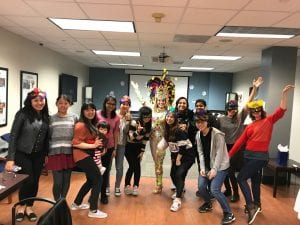 On Wednesday, I participated in the OISS International Ladies Network luncheon and took a Samba dance lesson. Actually, I’ve never seen Samba with my own eyes. I was so excited to see the dancer with her sparkly clothes. She was so beautiful and taught us in much detail. We learned several basic steps. We used the muscles of our foot a lot. I was so surprised to find that Samba needs a lot of energy even though the dancer had to keep their smile. The dance lesson was only one hour, but I had a great time and found how fun it is to dance Samba together.
On Wednesday, I participated in the OISS International Ladies Network luncheon and took a Samba dance lesson. Actually, I’ve never seen Samba with my own eyes. I was so excited to see the dancer with her sparkly clothes. She was so beautiful and taught us in much detail. We learned several basic steps. We used the muscles of our foot a lot. I was so surprised to find that Samba needs a lot of energy even though the dancer had to keep their smile. The dance lesson was only one hour, but I had a great time and found how fun it is to dance Samba together.
Research Project Update
Last week, I made a draft of my poster presentation with the exception of my results and discussion sections. This week, I had my professor check my draft. He gave me a lot of suggestions such as adding more explanations, changing the expressions into other ones, and so on. I not only modified it but also discussed the contents with him in order to make a poster which is easy to understand for people who don’t know physics very well.
In addition to this, I made a graph and wrote up my results, discussion, and future research sections. Actually, I had my professor check my draft over three times and had Dr. Gayle Moran check it too. Therefore I modified my poster over four times. It was a little bit hard but it was good opportunity to know how to make a research poster.
Week 04: Research in the U.S. vs. Research in Japan
As I mentioned before, there were no other researchers except me and my host, Prof. Geurts. Therefore, I didn’t feel there were any rules of the lab or in how people address each other. However, I did find some big difference between research in the U.S. and in Japan.
First, I found that even students called professors by their first name. This would be an unbelievable act in Japan. Also, there were is “keigo” in the U.S. really, so it was much easier to reply an email or Slack from my professor. In Japan, when I send an e-mail to a professor, I always have to first search how to write an e-mail to a professor on some website and check my text over and over before sending. A simple email requires a lot of work.
Second, students will share their own opinions directly with a professor even when their opinions are different. Actually, I tend to agree with the professor’s opinions even when I have other opinions. However, during my research at Rice, I changed my attitude and asked a lot of questions to my professor and shared my opinions with him. He often replied me, “Good question!” and gave me a detailed answer. I learned the importance of sharing opinions with each other regardless of your position.
In the final week in the lab, I made some patterns for my poster. Actually, in my brief five-minute practice presentation on Monday, I found my research was difficult for ordinary people to be understand. My friend from junior high school helped me with my poster by modifying it and gave me a lot of advice to make my poster and explanation of my research much easier to understand. Thanks to her advice, and practicing my speech over and over again, I could explain my research much better than I did on Monday. Actually, my previous host family came to the final colloquium at Rice University! When I was in the 10th grade, I studied abroad in Houston for another program. I was so glad to see them again for the first time in five years and to present my research to them. Moreover, my host professor also came to the colloquium and I was a little bit nervous to explain my research in front of him. It was the first time for me to make a research poster and make a speech in English! Time flew and I found how busy I was during the colloquium. It was such an exciting experience.
Finally, I will miss Houston so much. I will miss the support I had at Rice University from my host professor, friends at Rice, and my previous host family. I can’t thank them enough.
Final Research Project Overview
Research Project (PDF): “Identifying the Particles Produced by Au+Au Collisions”
Host Advisor: Prof. Frank Geurts, Dept. of Physics & Astronomy
Host Lab: Ultrarelavistic Heavy-Ion Physics Lab
I conducted research on quark gluon plasma(QGP). QGP occurred microseconds after the Big Bang and turned into hadrons such as protons and neutrons. The STAR experiment, conducted in Brookheaven National Laboratory, creates a lot of mini Big Bangs using a collider and reproduces QGP. However, the QGP lasts for very short time (for 3×10-23 sec!) and soon turns into hadrons and the generated hadrons have many types of particles. My research focused on identifying the types of particles generated. In order to identify a particle, we have to know the mass of the particle. By using the special relativity, mass is decided by the momentum and the velocity of the particle. I then made scatterplot of momentum and velocity and determined the value of mass by fitting the theoretical lines on the scatterplot. Finally, I could identify the types of particles generated including electrons, pions, kaons, and protons. Also, I found that pions were the most generated from the scatter plot and it could be understood that mesons such as pions are generated more easily than baryons such as protons. In the future, this research will lead to a deeper understanding of the characteristic of QGP.
Week 05: Science & Technology Policy Study Tour
During our final week in the U.S., at Lehigh University, I had a lunch with science and engineering faculty members. Actually, Prof. Geurts, my host at Rice, introduced me to Prof. Rosi Reed, who is one of his collaborators and a physics professor at Lehigh University. She was able to come to the lunch session and I was so glad to meet a female physics professor and talk about my research at Rice. Through this lunch session, I learned how an active female STEM researcher can be successful in their field, even though they are in the minority. This session made me to feel I should never give up in the physics field.
During our free sight-seeing time in Washington, D.C., I went to a number of Smithsonian Museums. I had heard that there were many kinds of museums and I could not visit all of them. However, the size of the museums was much larger than what I had imagined. I visited the Natural Science Museum, the National Air and Space Museum, National Museum of American History, and the National Museum of African American History and Culture. In particular, I was so excited to see the Hope Diamond with my own eyes. It was so beautiful and I thought its beauty has fascinated a lot of people.
Reflections on the Final Week of the Program
From participation in this program, I learned two important things about myself: one of my strong points is a thirst for knowledge and one of my week point is hesitation to ask for help. First, this program confirmed that I have a strong curiosity in physics; especially, in the universe and particle physics. Through the research internship at Rice University, I learned a lot of things about particle physics and I was so excited to participate in the research to understand the phenomena which occurred in the early universe. I believe this curiosity is a very important factor to become a researcher in the future, so I will never lose it. Second, I keenly felt at times that I didn’t have enough confidence in myself and I often hesitated to ask questions. I always made excuses such as “I am not as smart as the other physics students…”, “I have no time to do the task…”,or “My English is so bad, therefore I can’t say my opinion in English….” However, I learned how important it is to have confidence in myself and try to get a lot of information by asking questions or making contacts proactively. Everyone has time and information equally, but it is up to yourself how you will take advantage of these resources. After this program, I will study physics in a more focused way and make efforts to make contact with professors and Ph.D. students to learn more information about graduate school in the U.S. Finally, I will consider what kind of course is the best for me to follow to become an astrophysicist in the future. In conclusion, through the TOMODACHI STEM program, with a thirst of knowledge and greater confidence in myself, my will to make my dream come true has become much stronger.
When I arrived back in Japan, I could not believe that five weeks had passed since I left Japan in February. I went back home soon after I arrived at the airport. Actually, I had moved to another district in Tokyo just one week before I went to Houston. Thus, I had already stayed in the hotel in Houston four times longer than that in my new house; which made me feel a little bit strange. What I am most excited for about returning home is I can eat a lot of Japanese food. I love onigiri, miso-soup, sashimi, and so on! Furthermore, I am looking forward to visiting a Japanese convenience store and buying yakitori, salad-chicken, and many kinds of nikuman!
On the other hand, what I will miss about life in the U.S. is my best friends who I met through the TOMODACHI STEM program. In Houston, when I got up, I always said to my roommate “Good morning.” When I came back from the campus, they always asked me “How was your research today?”. When I went to bed, they told me “Good night.” How much what they said meant to me! Now, I am living alone in Tokyo, so I miss them so much.
Final Report
The meaning of the TOMODACHI STEM @ Rice University program to me is the great opportunity to interact with a lot of female STEM researchers and to learn about the differences in education and jobs between Japan and the U.S. It is said that the rate of female researchers in Japan is the smallest in the all developed countries. In particular, the rate of female researchers in physics is much smaller than other fields such as biology, chemistry and data science. Through this program, I could meet a lot of female researchers and female STEM students. I could interview them and learn about their attitudes and ways of thinking as a woman in STEM. I would not be able to have such a wonderful opportunity in Japan.
Also, this program offered a huge amount of information about studying at universities in the U.S. Before participating in the program, I thought it would take a lot of money to pursue a PhD course at a university in the U.S.. However, I found that international students in the U.S. can make their living by scholarships and financial support from their professors. I learned about the system of PhD courses in the U.S. from international students at Rice University and Lehigh University. In addition to this, I learned about various scholarships for Japanese students who study abroad when I visited the US-Japan Council in Washington, D.C. When I visited Dow Chemical in Houston, I talked with female researchers about the differences of jobs between Japan and the U.S. I was so surprised that there is no specific job hunting season in the U.S.. Moreover, I found that people who work for Dow Chemical in Houston were very proud of their jobs.
When speaking to a family member, I would say the program taught me to never give up my dream to become an astrophysicist in the future. During my stay in Houston, I lived with the participants in this program. I found out how hard they study in order to achieve their goal to become a female STEM researcher. Also, I had an interview with a female physics student at Rice University and she taught me to be proud of being a female physics student and not to make an excuse when I encountered some difficulty. I will study much harder now, not only astrophysics but also English, to be a researcher who can play on the global stage.
When speaking to a professor, I would say that I learned the importance of asking a lot of questions. Before participating in the program, I always hesitated to ask questions to professors. I was afraid they would think I was stupid. However, I found that it was common that students ask a lot of questions in class and asking questions showed how actively students participate in their classes. Thus, when I discussed with my host professor at Rice University, I always asked a large amount of questions. By doing so, I could understand my research topic much more deeply. A few weeks after the program, I become a junior in physics department at my home university in Japan. Now I try to ask some questions in every class. This act enables me to share my way of thinking with other students and the professor and motivates me to study physics even more.
When speaking to a future employer, I would say that I learned the importance of discussions with other people and understanding the differences in our sense of value, culture and so on. Through the program, I faced cultural differences between Japan and the U.S. Those differences gave me the opportunity to think about our customs and ways of thinking. The program taught me not only good points of Japan but also the bad ones. Thus, I got to accept various sense of values and I think this sense of acceptance is essential to communicate with each other when we work.
When speaking to a student at my university, I would say that I learned the necessity to study abroad. Actually, I had thought I had no ability to study abroad as a PhD student or a researcher. However, in this program I researched particle physics through discussions with my host professor almost every day and listened to a lot of experiences of others who were studying at a university or an institution in the U.S.. This gave me the confidence that even I had could an opportunity to apply the university in the U.S. and conduct physics research there. After coming back to Japan, I researched the system of studying abroad to the U.S. and listened to the students from my home university, who have been accepted to a PhD course in the U.S. Even as a junior (B3) student I can now begin to look into these opportunities.
Moreover, I believe that other undergraduate students in Japan should apply for this program. This is because that the TOMODACHI STEM program is a really excellent opportunity to research in your own major in English and make a good connections with many people such as other participants, professors, students in the U.S., lecturers, and so on. I had a really great time in the U.S.. My appreciation can’t be expressed in words.
Return to Top
Tips for Future Participants
Packing Tips: You should bring your water bottle or buy one at the Rice University. That is because bottled water in the U.S. is so expensive; it costs three times as in Japan. However, there are a lot of water fountains on campus, so you should use them. Also, you should bring a device which measures the weight your suit case. It is very useful before you leave Houston and Washington DC.
Money in the U.S.: You don’t have to take $100 or $50 bills. That is because you will pay such amount money by your credit card. However, if you have some $5 or $1 bills that will be helpful. The $1 bill is often used to give tips to your hotel driver. Also, you will need to exchange your $5 or $1 bills into quarter coins when you use the coin laundry at the hotel.
Working with your Research Lab: When you don’t understand or don’t have much knowledge about your research, don’t hesitate to ask questions to your host professor or your mentors. It is natural for you to not yet understand the detail about your research topic because you’re an undergraduate student. If you ask them, they will be willing to answer your questions. At that time, you don’t have to say “I am sorry to bother you”, but you should say “Thank you very much! I understand my research topic more deeply.”
Things to Do: In Houston, you should go to a lot of museums on the weekends. Also, you should participate in many events held in Rice University. For example, I appreciated the orchestra and opera concerts at night at the Shepherd School, and participated in a samba lesson as part of the OISS Ladies Network Lunch.
[:]

